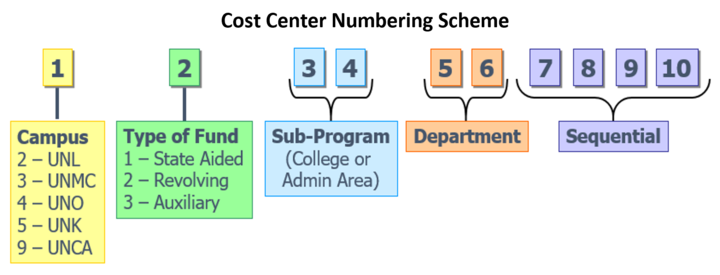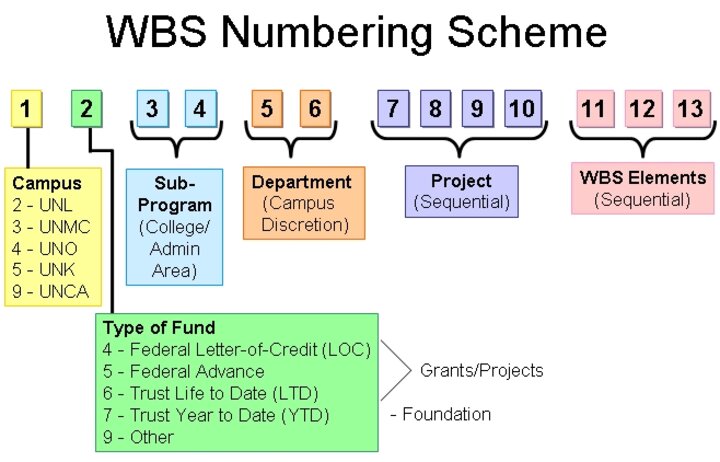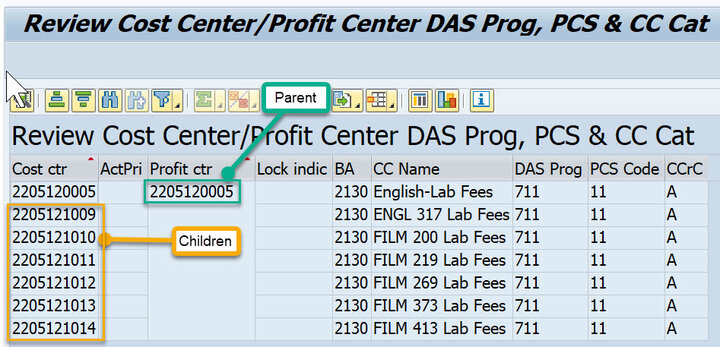To request a new or update an existing cost center, contact your business center or financial staff.
A cost object number is a unique identifier that describes a source of funds, similar to a bank account number. When UNL’s funding is distributed to departments for use, each portion of funding is identified with a cost object number. The University has thousands of cost objects, but each cost object is assigned to a department that is responsible for properly managing those funds.
The phrase “cost object” refers to two types of numbers:
- Cost centers are 10-digit numbers used to track income and expenses for state aided, revolving and auxiliary funds.
- WBS numbers are 13 digits and are used to track income and expenses for grants and contracts, and funds from the University Foundation.
Cost objects are used to segregate financial activity based on type of operation. They are smart numbered so you can see what type of cost object it is and who owns it by looking at the different digits of the cost object number. The numbering schemes identify the campus, fund type, and sub-program and department responsible for the funding. Below is an illustration of the numbering structure for a cost center and a WBS.


Cost Object Ownership: Subprograms and Departments
Sub-programs and departments are used in the smart numbering of cost objects to identify who owns the cost object.
The sub-program is a 2-digit code that identifies the college or vice chancellor. The department is also a 2-digit code used to identify a specific department. The department code is always used in conjunction with the sub-program code. For example, department 12 can exist in multiple sub-programs so it is not useful to just look for department 12. Instead, look for department 12 within a specific sub-program. See below examples:
0512 = College of Arts & Sciences, English
4312 = Business & Finance, Budget
The complete sub-programs and department list is available in Sapphire. Viewing this list requires TrueYou authentication.
Cost Centers: The last four digits

Parent vs. Child Cost Centers
When creating new cost centers (used for State-aided, revolving, auxiliary funds), UNL Accounting uses the last four digits of the cost center number to distinguish parent cost centers from child cost centers. Parent cost centers are assigned numbers ending in digits less than 1000 and may include several associated child cost centers. Child cost centers are assigned numbers ending in 1000 or greater, allowing for more detailed tracking of specific transactions.
This structure—commonly referred to by UNL Accounting staff as “the 1000 Rule”—helps consolidate transactions under a parent cost center for easier financial analysis while still providing detailed tracking through associated child cost centers.
Exceptions:
Some State-Aided cost centers do not follow the 1000 Rule. In these cases, the last four digits are used instead to identify the funding source, as shown in this table.
Find Parent/Child Relationship
The SAP transaction code Y_UNS_83000191 provides a report that shows all the child cost centers that belong to a parent cost center. After entering the transaction code, enter the cost center of interest.

Request New or Modify Existing Cost Center
Business staff are responsible for requesting new or changes to cost centers. If your department needs a new cost center or needs to modify an existing cost center, please contact your business center or financial staff.
Resources
UNL Funding and Cost Objects - This video (8:50) introduces UNL's main funding sources and explains how funds are identified with the cost object numbering system.